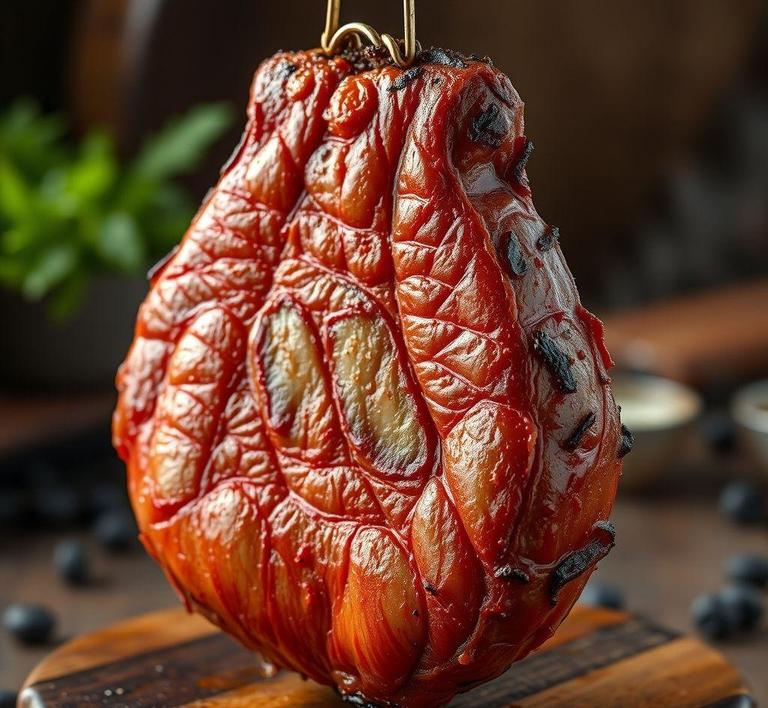When it comes to preserving that delicious smoked meat for longer, refreezing can be a great option-but it’s not always straightforward. Smoked meats are typically packed with flavor, and while they freeze well, knowing the right steps to safely refreeze them is key to maintaining that smoky goodness. This guide will walk you through how to properly refreeze smoked meat, ensuring it stays tasty and safe to eat, while also helping you avoid any potential texture or flavor loss. Whether you have leftovers from a BBQ or you’re stocking up on smoked meats for the future, you’ll want to get it right, and we’re here to help!
Can You Refreeze Smoked Meat?

When it comes to smoked meat, the question of whether or not it can be refrozen is one that many home cooks, BBQ enthusiasts, and leftover lovers ask. The short answer is yes, you can refreeze smoked meat, but the situation requires some careful consideration. Smoked meat, like any other type of meat, undergoes changes when frozen, thawed, and refrozen. The process of freezing preserves the meat’s safety by slowing down bacterial growth, but it can also impact the texture, flavor, and quality of the meat.
The primary concern with refreezing smoked meat, or any meat for that matter, stems from the possibility of spoilage or the loss of texture due to the freezing and thawing process. When meat is frozen, ice crystals form within the tissue. As the meat thaws, these ice crystals melt and can cause the muscle fibers to break down, leading to a mushier texture. This can be especially noticeable in smoked meat, where the smoking process already gives the meat a certain amount of tenderness and flavor complexity. Refreezing can exacerbate this breakdown, potentially turning a once-tender, smoky piece of brisket or ribs into a drier and less appetizing dish.
However, as long as the smoked meat was properly handled and never left at room temperature for more than a couple of hours, you can refreeze it safely. But there’s more to consider, especially in terms of its quality after refreezing.
How To Refreeze Smoked Meat?
If you’ve decided to refreeze your smoked meat, it’s important to do so with care to maintain the best possible outcome in terms of safety and quality. The following steps will guide you through the process:
- Cool the Meat Properly: Before freezing, ensure that the smoked meat has been properly cooled down. If you’re refreezing leftovers, let the meat cool to room temperature, but don’t leave it out for more than two hours. The faster you cool it, the less risk there is for bacterial growth. You can use a shallow container or slice the meat into smaller portions to speed up the cooling process.
- Wrap the Meat Well: Proper wrapping is crucial for preserving the quality of the meat and avoiding freezer burn. Use plastic wrap, aluminum foil, or a vacuum-sealed bag. If you’re using a vacuum sealer, this is ideal, as it removes air and prevents moisture loss, keeping the meat moist when it’s thawed later. If you’re using regular freezer bags, ensure there’s as little air as possible inside, and double-bag the meat if needed for extra protection.
- Label and Date: It’s important to label the meat with the date it was smoked and frozen, especially if you’re storing multiple types of smoked meats or if you plan on keeping the meat in the freezer for an extended period. Smoked meat should ideally be consumed within 2-3 months of being frozen to ensure the best quality, though it can remain safe to eat longer if properly stored.
- Freeze Quickly: Place the meat in the coldest part of your freezer to ensure it freezes quickly. This helps maintain its texture and prevents the formation of large ice crystals, which can break down the meat fibers more severely.
- Thaw Carefully: Once you’re ready to use the refrozen smoked meat, make sure to thaw it properly. The best method is to place it in the fridge for 24-48 hours to allow for slow, safe thawing. Rapid thawing in hot water or at room temperature can encourage bacterial growth and compromise the meat’s safety.
Quality Impact
While the safety of refreezing smoked meat is generally not a problem if proper handling and storage guidelines are followed, the quality of the meat after being refrozen is another matter. The impact on quality largely depends on how the meat is cooked, frozen, and thawed. Below are some key factors to consider:
- Texture: One of the most noticeable changes when you refreeze smoked meat is its texture. Smoked meats, particularly fatty cuts like brisket, ribs, or pork shoulder, tend to lose moisture during the freezing and thawing process. The fat that was once a tenderizing element may become more solidified and greasy, and the meat itself can become drier or more fibrous. This loss of moisture is one of the primary reasons that refrozen smoked meat can feel less juicy and tender.
- Flavor: Smoked meat gets its unique flavor profile from the slow smoking process, which imparts deep, rich, and often smoky or spicy notes. Freezing and thawing may cause some of these flavors to dissipate or become muted, particularly if the meat was smoked with a heavy glaze or sauce that could be affected by freezing. Additionally, repeated freezing and thawing cycles can lead to flavor loss, as the meat’s natural juices (which carry a lot of the flavor) leak out.
- Moisture Loss: When smoked meat is frozen, the water inside the meat forms ice crystals. When thawed, these crystals melt, and some of the meat’s moisture is lost in the process. This can leave the meat feeling drier and less flavorful than before. The type of meat you’re freezing makes a big difference here. Fatty cuts like pork belly or ribeye might hold up better to freezing than leaner meats like chicken breast or turkey.
- Overall Quality: While safety can be ensured with proper freezing techniques, the overall quality of the smoked meat after refreezing may not meet the same high standards as it did fresh. The more times meat is frozen and thawed, the greater the degradation in its texture and flavor. So, while it’s safe to refreeze once, consider whether it’s worth doing so multiple times.
Refreezing smoked meat is possible, but it comes with trade-offs. From a food safety standpoint, as long as the meat has been properly handled, cooled, and stored, there’s no significant risk of harm. However, when it comes to quality, refreezing can lead to dry, less flavorful meat due to moisture loss and texture changes.
For the best experience, it’s ideal to consume smoked meat within a few days of cooking or after initially freezing it. If you must refreeze, follow the steps outlined to minimize quality degradation, and be prepared for some loss in texture and flavor. Ultimately, while smoked meat can be refrozen in a pinch, it’s best to enjoy it fresh or within a reasonable time frame to ensure you’re getting the most out of that delicious smoky goodness!
Is It Safe To Refreeze Smoked Meat?
Smoked meat is often cherished for its rich flavor, tender texture, and that unmistakable smoky aroma. Whether it’s brisket, sausage, turkey, or ham, smoked meat can be a star at any meal, often making its way into leftovers after a big feast. But what if you’re faced with leftover smoked meat? Can you refreeze it safely?
The short answer is: Yes, but with some important caveats.
Refreezing smoked meat can be done safely under the right conditions. However, it’s essential to consider the state of the meat before refreezing it. If the smoked meat was properly thawed in the refrigerator (never at room temperature), and hasn’t been left out for extended periods, it’s generally safe to refreeze it. Smoked meat is already cured, which provides a level of preservation. However, keep in mind that each freeze-thaw cycle can affect the texture and quality of the meat. The freezing process causes ice crystals to form in the cells of the meat, which can rupture cell walls. When refrozen, this damage can result in a loss of moisture, which may cause the meat to become dry or tough after reheating.
Another important consideration is how long the meat has been out of the freezer. If the meat was thawed improperly (like on the countertop) or has been stored for too long after being defrosted, refreezing could compromise food safety, potentially leading to bacterial growth. As with all meats, the key to safety lies in how quickly and consistently you handle it after it’s thawed.
Signs That Smoked Meat Should Not Be Refrozen
Refreezing smoked meat may seem convenient, but there are instances when it should be avoided for both quality and safety reasons. Here are some signs that smoked meat should not be refrozen:
- It Was Left Out Too Long: If smoked meat has been left out at room temperature for more than two hours (or one hour if the room temperature is above 90°F/32°C), it’s no longer safe to refreeze. Bacteria multiply rapidly in these conditions, and refreezing would not kill harmful pathogens; instead, it could further contaminate the meat when thawed again.
- The Meat Has a Strange Smell: If your smoked meat has started to smell sour, rancid, or off in any way, it’s a clear indicator that it has gone bad. Meat that’s begun to spoil should not be refrozen, as it may pose a food safety risk.
- Excess Moisture or Freezer Burn: If the meat looks excessively wet, slimy, or there’s a lot of moisture in the packaging, this could indicate that it has already been thawed and refrozen before, or that it’s been sitting in a freezer for too long. Excess moisture can degrade the texture and flavor significantly. Additionally, freezer burn, which appears as dry, discolored spots on the meat, is a sign that the meat has been exposed to air and should likely be discarded if it’s too far gone.
- It Was Thawed Improperly: If the meat was thawed outside of the refrigerator, say on the counter or under warm water, refreezing should be avoided. Thawing improperly can cause the meat to enter the danger zone (40°F-140°F/4°C-60°C), where bacteria can grow rapidly.
- Excessive Weight Loss: If smoked meat has lost a significant amount of moisture or weight from being stored in the freezer too long, it may be a sign that it’s lost its integrity. While some moisture loss is inevitable, excessive dehydration or shrinkage could indicate that refreezing would only result in a dry, unpleasant texture.
Common Refreezing Mistakes
Refreezing meat isn’t a simple task, and there are a few common pitfalls people fall into when attempting to preserve smoked meat. Here are some of the most common mistakes and how to avoid them:
- Not Using Proper Packaging: When refreezing smoked meat, it’s crucial to use airtight, freezer-safe packaging. If the meat isn’t sealed properly, it can suffer from freezer burn, which will dry out the meat and lead to flavor loss. Always use heavy-duty plastic wrap, freezer paper, or vacuum-sealed bags to lock out air and moisture.
- Refreezing After Multiple Thaws: Some people may thaw smoked meat multiple times before using it, but each thawing and refreezing cycle worsens the quality of the meat. Not only does it lose moisture and flavor with every freeze-thaw cycle, but repeated thawing also opens up opportunities for bacterial contamination.
- Refreezing Without Cooling First: It’s tempting to toss leftover smoked meat directly into the freezer, but it’s essential to first allow it to cool in the refrigerator for several hours before freezing. Putting hot food straight into the freezer can raise the internal temperature of your freezer and promote bacterial growth. Always cool the meat to room temperature (within two hours) before freezing.
- Not Labeling Frozen Meat: If you’re refreezing smoked meat, label it with the date you froze it. This way, you can keep track of how long it’s been in the freezer. Smoked meat should ideally be consumed within 1-3 months of refreezing for the best flavor and texture. Without labeling, it can be easy to forget how long it’s been stored.
- Ignoring Portion Sizes: It’s easy to refreeze an entire slab of smoked meat, but when you’re ready to reheat it, you may not need that much. Cutting the meat into portions before freezing it again allows you to thaw only what you need, preventing unnecessary refreezing.
Tips And Tricks
To make the process of refreezing smoked meat as efficient and high-quality as possible, consider the following tips and tricks:
- Vacuum Seal for Best Results: If you have a vacuum sealer, use it to package the smoked meat before freezing. Vacuum sealing removes air and prevents freezer burn, ensuring that the meat retains its moisture and flavor better than if it were simply wrapped in plastic.
- Cool Meat Quickly: To prevent bacteria growth and preserve quality, ensure that leftover smoked meat cools as quickly as possible. Cut the meat into smaller pieces to help it cool faster before placing it in the fridge or freezer.
- Use the Right Freezing Containers: If you don’t have a vacuum sealer, use freezer-safe plastic bags or containers. When using bags, remove as much air as possible before sealing. Freezer-safe containers should be durable enough to avoid cracking in the cold temperatures.
- Avoid Storing for Too Long: Even though it’s technically safe to refreeze smoked meat, don’t keep it in the freezer indefinitely. The longer it’s stored, the more its texture and flavor degrade. Try to consume refrozen smoked meat within 1-3 months for the best quality.
- Thaw Properly: Always thaw refrozen smoked meat in the refrigerator rather than at room temperature. The gradual thawing process ensures the meat stays at a safe temperature and retains its texture.
Conclusion
Refreezing smoked meat is generally safe, but it requires careful handling to preserve both the quality and safety of the meat. The key is to make sure the meat has been thawed and stored properly, and that it hasn’t been exposed to unsafe temperatures for extended periods. While refreezing might cause a slight loss in texture, as long as you follow the right steps and avoid common mistakes, it’s a great way to extend the shelf life of your leftovers. Whether you’re dealing with a smoked turkey, brisket, or sausages, the same rules apply: handle with care, freeze promptly, and make sure to enjoy the meat within a reasonable time frame to get the most out of it.


